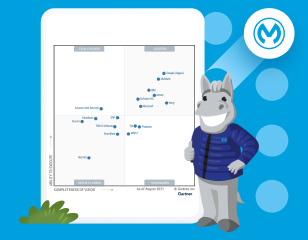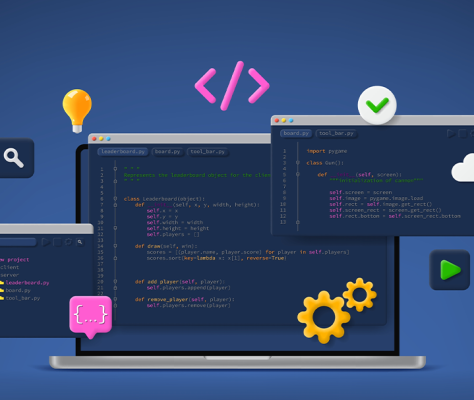As digital transformation accelerates, so does the need for enterprise integration. With businesses aligning their ecosystem of data, applications, and systems to their business goals, efficiency, and better-connected experiences takes on new urgency – and puts an emphasis on the question of “when,” not “if.”
According to the 2021 connectivity benchmark report, organizations are embracing APIs in integration projects, and generating 27% of their revenue from APIs and related implementations. But less than a third of apps are currently integrated: 53% of enterprises deploy over 800 applications, while 43% have more than 1,000 applications, each with a lifespan of four years – you do the math. As businesses strive for a cost-effective approach, this strategy will become unsustainable without integration.
In this blog post, we will provide a high-level overview of integration, introduce the building blocks of API integration, and touch on the key to defining a great API strategy.
What is an integration strategy?
Before approaching integration strategy headfirst, it’s important to understand system integration at its core. Integration itself is the process of connecting multiple enterprise systems to function as a collaborative unit. On a similar note, integration strategy refers to the process, procedure, and roadmap an IT team establishes to deliver their business integration objectives.
When pursuing an integration strategy, it’s helpful to assess your options and probe the question of which game plan best fits your overall vision – and as companies across the board integrate their systems in numerous ways, one course of action is API-led connectivity.
API integration has become a secure solution for organizations, creating flexible communication between applications, as well as enabling workers to enjoy benefits of cloud-based apps while spearheading innovation. Likewise, strategies that involve API integration also empower organizations to effectively launch disruptive initiatives, without costing extra time or earnings.
Building blocks of API integration
There are multiple integration building blocks that make up the integration space, and these constructs drive productizations in the development cycle, and act as critical components to understanding enterprise strategies.
- APIs: Software intermediary that provide applications a secure way to interact (send or receive information) with each other – typically to trigger an operation within that application.
- Connectors: Pre-packaged code that simplifies and hides connectivity and operational details of the underlying application for which the connector exists. Connectors are used when working with a commercial-off-the-shelf (COTS) application that carries an existing connector.
- Code templates: Prebuilt applications of complex pieces of code that are imported across multiple projects as-is, for reuse of functionality or customization. These templates act as an added impetus for developers and help with faster application development.
- API fragments: Reusable components of RAML specifications (data objectives, behavior, or documentation) that develop units for designing APIs.
- Messages: Formal pieces of data objects (collection of attributes and values) that are shared between two or more applications. Messages are distributed within the context of a Java Message Service (JMS) compliant messaging infrastructure.
- Queue, exchange, topics: Channels within the messaging system that aid in dispatching messages between the applications.
- API policies: Practices that enable enforcement of regulations, management, security, and quality of service of multiple APIs — such as, security, traffic control, service level agreements, etc.
- Common services: Utility not provided by the platform as-is, but customers themselves can develop commonly-used applications and use them across several applications and/or APIs. Examples include: caching framework, logging framework, auditing framework, etc.
- Security groups: Aggregation of similar user roles and grant necessary permissions for those roles. Once defined, a security group can be used within or across projects.
Building an API integration strategy
The first step to building an API integration strategy is collecting information about known systems. It’s essential to ask line of business teams which applications and systems are being used, and what they may further include in their tech stack. Also, compare the different integration strategy methods:
- Big-bang approach: Integrating all systems at once.
- Integration “with the stream”: Integrating systems on a project-by-project basis.
- Incremental: Integrating systems on a priority-basis, focusing on a few each time.
- Top-down/bottom-up: Integrating in order of system’s utilization or importance.
Without an integration strategy, IT teams integrate systems on an ad-hoc basis. This delays productivity and curbs enterprise acceleration toward digital transformation, as IT teams delegate more time on low-level integration responsibilities. Approximately 83% of organizations undergoing digital transformation want to drive IT efficiency, and building an integration strategy helps teams to align their project goals.
Additionally, consider these benefits of creating a valuable, API integration strategy:
- Integration simplified: An API as an component simplifies the ability for applications to communicate information with one another, and also augment their capacity to deliver diverse tasks.
- Integration improved: APIs also facilitate integration, which allow separate software platforms to align their interrelationships according to org-specific needs. In this way, companies can optimize better outcomes while minimizing development costs.
Read our whitepaper to understand the value of API integration in today’s digital economy, and see best practices for developing a winning API product strategy.









